

|
|
|
|
|
An oft-used abbreviation in the annotations below is KGNP = Kalahari-Gemsbok National Park [which is actually now called Kgladigladi Transfrontier Park as much of it also extends into Botswana]; NP = National Park. |
| Lion Panthera leo | Three lions hung out at the Okaukeujo waterhole in Etosha NP one night. There was an adult male, a female, and a young male. The latter chased giraffes about very clumsily. The male roared all night long — we could hear him from our chalet just a few yards from the waterhole. This was not a great trip for large cats and although we found fresh lion tracks several times (Kalahari-Gemsbok NP and Mahango Reserve) we never saw any others. |
| Wild Cat Felis sylvestris | Two were seen during a night drive in KGNP; we also learned that there is a current research project on this species there. I watched another grab a baby hyrax from a colony at Erongo Wilderness Lodge and run off with it — to the consternation of the entire colony which took up loud yelping as they chased after the cat |
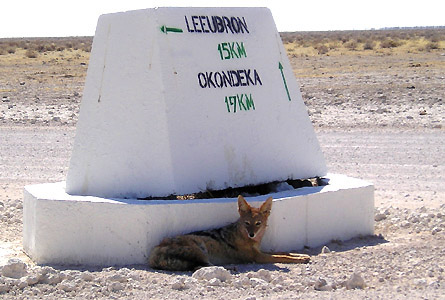 |
Canis mesomelas Jackals were seen daily in KGNP — both during the day and on night drives — and most often in pairs. Additional animals were at Anib Lodge and Etosha NP. This one (left) has found a shady spot during the mid-day heat in Etosha. |
| Cape Fox Vulpes chama * | One seen well on a night drive through the karoo outside Brandvlei and then eight were seen on a Kalahari desert night drive. |
| Bat-eared Fox Otocyon megalotis | Our only ones were on a late afternoon-evening night drive at Anib Lodge in Namibia, and we saw about 10 here. This scarcity was a surprise as well had many more encounters during out visits to east Africa. |
|
Ictonyx striatus * "Zorilla" is just a superb name. The beast itself recalls our skunks in America. We were thrilled to see a wild one during a night drive at Augrabies Falls NP. We were then saddened to find a fresh road-kill (right) out near Uis in northwestern Namibia. |
 |
| Ratel (Honey Badger) Mellivora capensis * | One watched scuttling through the scrub during our drive near Namutoni Camp in Etosha NP. Occupants of another car had spotted it (perhaps in crossed the road in front of them) but our views were not great. Another was said to visit Halali Camp every night but we didn't see it during our evening stroll. It apparently came to knock over garbage cans much later that night. |
| Slender Mongoose Herpestes sanguinea | This small mongoose was seen in KGNP, near Fish River Canyon, and near Erongo Wilderness Lodge |
| Small Gray Mongoose Galerella pulverulenta * | Two individuals were seen in Augrabies Falls NP |
| Banded Mongoose Mungos mungo | A party of a dozen was foraging together at dusk inside Namutoni Camp in Etosha NP |
|
Cynictis penicillata This was the common mongoose in the dry interior; it was seen almost daily in Kalahari scrub habitat, north of Brandvlei, through Etosha NP. Some were rather tame in KGNP camps. This shot (right), of an adult with just-caught prey, was along the road near Kaimois, South Africa, and far from any park. I am very pleased with the composition of this shot; note the flowers blooming in the background. |
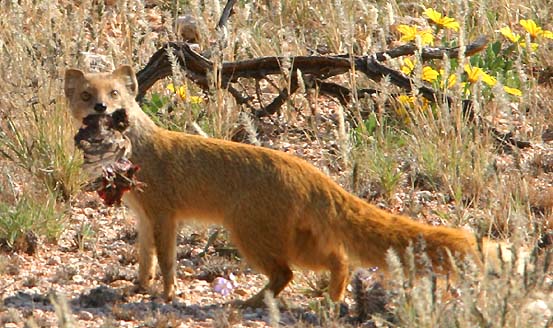 |
| Meerkat (Suricate) Suricata suricatta | We came upon one small colony of a half-dozen in KGNP but they were very skittish. I had thought we'd see more but that was it; there was never an opportunity for photos |
 |
| Spotted Hyena Crocuta crocula * | Two visited the waterhole at Halali Camp in Etosha early one morning. We had much more dramatic encounters in east Africa. |
| Aardwolf Proteles cristatus * | One was spotted near the road during a night drive in KGNP. What a treat! We had great views of the entire animal in the spotlight. It ran away from us but stopped to turn and look back. This species exists only on certain specific species of termites, and is almost entirely nocturnal. It was truly a stroke of luck to see one well. |
| Large-spotted (Blotched) Genet Genetta trigrina | One seen at night near N'kwazi Camp on the Kavango River |
| Southern Right-Whale Balaena australis * | Four large whales blowing in the center of Walker Bay provided distant views. It was unfortunate that they weren't right up next to shore as they can sometimes be. |
| Cape Fur Seal Actocephalus pusillus * | Over a thousand were in residence on Dyer Island; a prime breeding spot (below). It is because of these seals that the Great White Sharks are cruising the perimeter. Hundreds more were seen during the pelagic trip and off the Cape of Good Hope. |
 |
| Lesser Galago (Bush Baby) Galago moholi * | Two of these delightful little primates were feeding and leaping about flowering trees near our chalets in Waterburg NP. We saw them with Richard's spotlight during an evening stroll. |
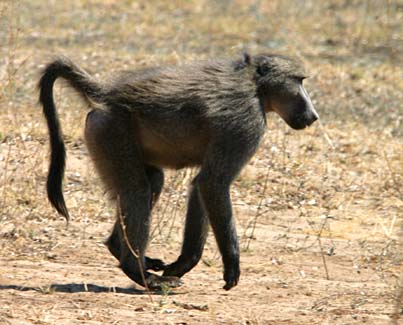 |
Papio ursinus Local and widespread: we had parties in Cape of Good Hope NP (where they are re-introduced); in rocky country from Augrabies Falls NP to Erongo Wilderness Lodge (where they made quite a racket); and then daily along Okavango River (Mahango Reserve [this shot, left] and in Botswana) |
|
Cercophithecus aethiops This widespread African species of savanna and thorn forest was encountered only at Augrabies Falls NP (right) and in the woods around Xaro Camp in Botswana. We were very familiar with them from prior visits to east Africa. |
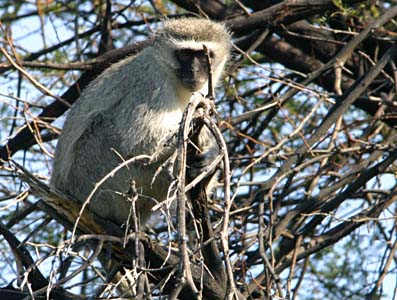 |
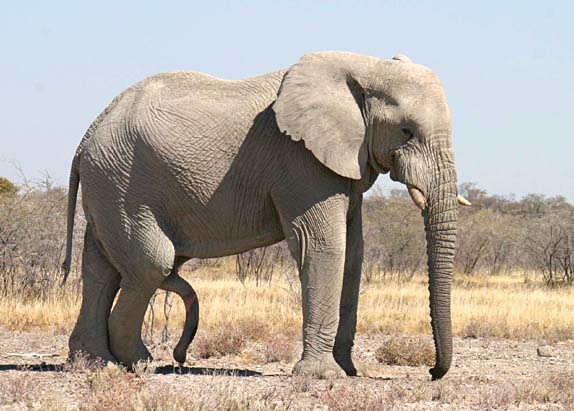 |
We had small parties of elephant most days in Etosha NP, and especially at waterholes at night. This 'happy-to-see-you' male was the largest one we encountered during the day. His tusks were broken, though, possible through digging in this hard, arid land. We some substantial evidence (e.g., uprooted trees) of elephants along the Okavango River but did not see their hides there. |
|
Procavia capensis Hyraxes were common and widespread in rocky jumbles, mountains, and cliffs throughout southwestern Africa. We recorded them from the Cape Town area to KGNP, from Augrabies Falls to Fish River Canyon to the Erongo Mountains, and again at Waterburg NP. Hyraxes are smallish, woolly mammals with no visible tail and 'hoofed' digits. They were once grouped with rodents, and then later with elephants (because they were ungulates), but they have been placed in an Order of their own [Hyracoidea] for some decades now. They feed mostly on grass; have three-chambered 'stomachs' for digestion; and have a poor ability to control their body temperature. For this reason they sun themselves on rocks (mother and youngster, below right) and have long period of inactivity. Adult territorial males (below left) keep watch and give a sharp yelp if danger is sensed. Then the entire colony dashes into the rocks. The locals call then "dassies."
|
| Kaokoveld Rock Hyrax Procavia welwitchii | Hyraxes seen at Spitzkoppe were this species on range (split by both Macdonald 19984 & Kingdon 1997 but considered a subspecies of capensis by others). We did not study them in detail; they were rather shy here. |
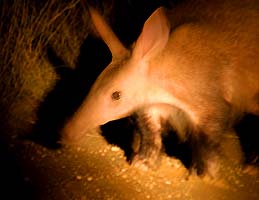 |
Orycteropus after * We really did see an Aardvark. I almost have to pinch myself to believe it. This is one of the most mythical beasts in Africa: no one ever sees one (although you find their burrows widely). Ours crossed the road and then up toward the car during a night drive in the karoo outside Brandvlei. This photo (left) is taken handheld without flash using only the beam in Richard's spotlight. This is a big beast: size of German Shephard! It was certainly the "mammal of the trip." |
|
Equus burchelli Common in Etosha NP (up to 250/day), and a few in Mahango Reserve, where they are protected. None seen outsize of national parks and reserves. This shot of mother and colt (right) was near one of Etosha's waterholes. |
 |
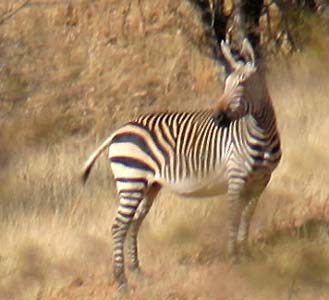 |
Equus zebra * After quite a search, we found a party of five animals in Daan Viljoen Game Reserve, east of Windhoek, on the final morning of the trip. This species almost went extinct with hunting and land conversion, and is now limited in distribution to a very few reserves in southwestern Africa. This photo was taken at a long distance, but note the broad hip stripes, the white belly, and the long ears. |
|
Diceros bicornis Seven at night at Okaukuejo waterhole in Etosha NP our first evening was great, but the real thrill was the next day when this mother (right) brought her very small baby in to the waterhole at dusk. Mom had a very impressive horn; baby was so young she didn't drink water yet. After dark another 9 rhinos visited. This is a wonderful comeback from the days of near extinction. |
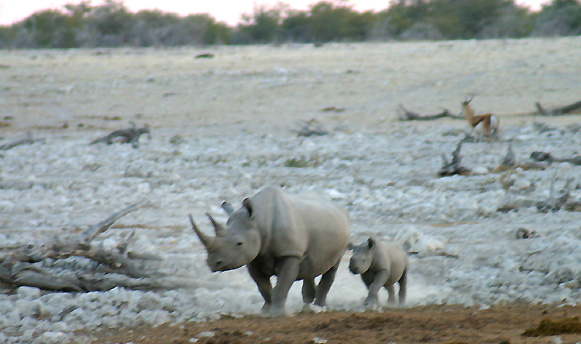 |
 |
Phacochoerus africanus Surprisingly absent from South Africa, we finally saw two (left) at a waterhole in Etosha NP. They became regular only when we reached the Okavango River, and then a few were seen daily in Mahango Reserve or along the banks of the river. |
| Hippopotamus Hippopotamus amphibius | We had them only in the Okavango Delta, and here they were retiring and not often seen. We HEARD them all night long, though, at Xaro Camp: loud snorts in the river in front of our chalet. The close-cropped grass here was mostly due to their night feeding. We saw some at a distance at Mahango Game Reserve; they were feeding out of the water at the edge of the grassy swamp. |
|
Giraffa camelopardalis There is nothing quite like a giraffe striding across the African plain. Giraffes were not at all common, as they are in east Africa parks, but are rather patchily distributed in this dry country. We had a grand total of 3 in KGNP but did see small numbers daily in Etosha NP.
|
|
Taurotragus oryx This is a large but shy antelope that we saw only twice, and both times they were re-introduced populations: Cape of Good Hope NP (~20) and four (1 male, 3 female) at Daan Viljoen Reserve outside Windhoek (photo of male, right) |
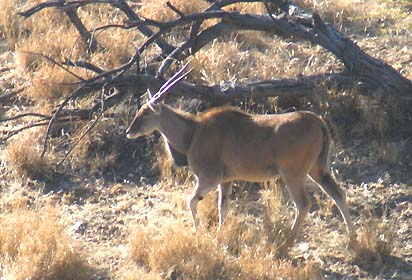 |
|
Tragelaphus strepsiceros A few daily in Etosha Nat'l Park but not common (max 8/day; photo below right is of a lovely big-horned male at a waterhole there); a few were also seen on both visits to Mahango Reserve, and then scattered individuals were in open country on the drive back toward and from the Waterburg in northwest Namibia. Also reintroduced at Anib Lodge. Red-billed Oxpeckers were riding this female at Mahango (below left)
|
| Bushbuck Tragelaphus scriptus | Single females were seen twice in the Okavango Delta of Botswana, and each time they quickly disappeared from view. One was at Xaro Lodge during a late afternoon stroll. |
|
Tragelaphus spekei * This much-wanted swamp antelope was seen twice in the Okavango Delta, both times on small flooded openings in the papyrus-lined river. Both were females: our closest one (right) was just a brief look at the head and neck and then she was gone . . . This is an exceptionally shy antelope and specially adapted with 'high-heel' hoofs for an aquatic existence. |
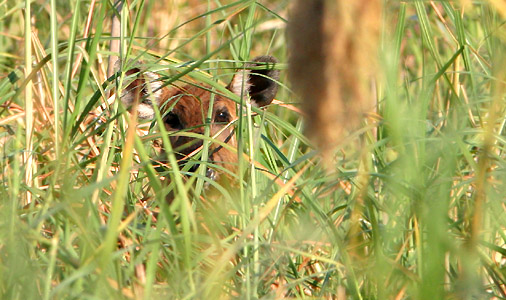 |
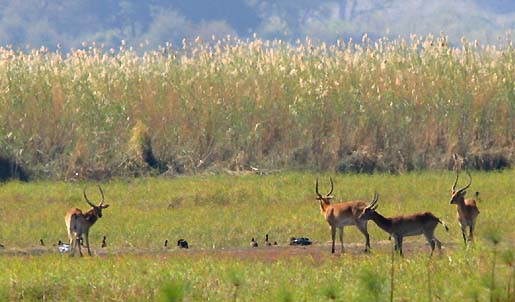 |
Kobus leche * These are also semi-aquatic antelope, but unlike the Sitatunga they feed out in the open lightly-flooded plains. We saw them only at a distance at Mahango Game Reserve (left). They are apparently the primary prior for prides of lion in the watery Okavango Delta [the birds shown are White-faced Whistling-Ducks] |
|
Hippotragus niger A gorgeous antelope, we encountered small herds on both visitis to Mahango Game Reserve. They are in the tribe Hippotragini, the 'horse-like antelope,' as is the next species. The two shown (right) are impressive males. |
 |
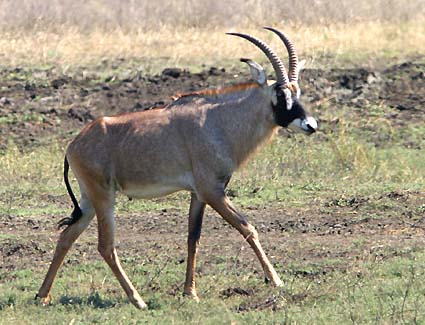 |
Hippotragus equinus * Another striking large antelope which, like the Sable, is very smart-looking (left). Like the Sable, we found them only in Mahango Game Reserve on our trip. They have been on the decline throughout Africa. |
|
Oryx gazella Common and widespread in the interior but almost all of them were in the parks: large numbers daily in KGNP and Etosha NP (100+/day). This photo (right) was taken at Anib Lodge, though, where they have been re-introduced. It is impressive to see this large long-horned antelope in such numbers. The locals all use the term Gemsbok (with a Germanic guttural pronunciation that is rather like "hemms-bok"). In east Africa they are called Oryx. |
 |
|
Connochaetes taurinus This species of many names (White-bearded Gnu, Brindled Gnu) is famous for its migrations across the interior of east and southern Africa. Some percentage of the populations, though, may be resident. We encountered small herds daily in KGNP and Etosha NP (and nowhere else). Herds would come daily to waterholes to drink (below left) but would spook and panic (below right) if any danger was suggested.
|
|
Alcelaphus buselaphus Only small numbers of this distinctive antelope were encountered. We saw exactly one in KGNP but had small hers (up to 25/day) in Etosha NP. |
 |
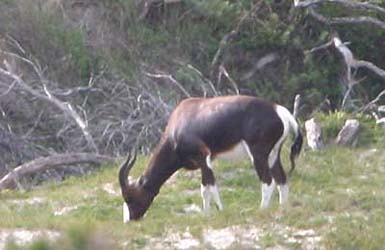 |
Damliscus dorcas dorcas * This strikingly patterned antelope is no longer found anywhere in their original wild state (Kingdon 1997). They were an isolated population in grasslands among fynbos around the Cape. Today a re-introduced population exists in Cape of Good Hope NP (photo left). The other subspecies [D. d. phillipsi] is known as the Blesbok. It is a paler reddish-brown and the white areas are not as well-defined as on Bontebok. It, too, exists only where re-introduced. We five re-introduced Blesbok in the late afternoon drive at Anib Lodge, Namibia. |
|
Aepyceros melampus Unlike east Africa, where this is the common antelope, only small herds were in Etosha NP and again in Mahango Reserve. These populations have black blazes on the male's muzzle (right) and are called 'Black-faced Impala' A. m. petersi (sometimes treated as a separate species) |
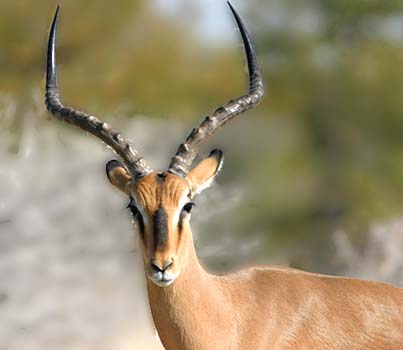 |
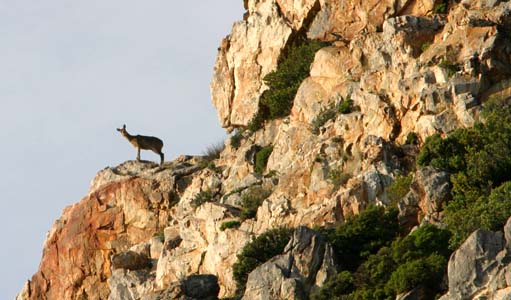 |
Oreotragus oreotragus I have full frame photos from Augrabies Falls NP, but I just really like this 'beast-in-habitat' shot from Walker Bay, east of Cape Town, where it is quite lucky to see one. They were tame and right next to the road at Augrabies Falls NP (up to 8/day). |
|
Antidorcas marsupialis The common and widespread antelope throughout the trip (except Okavango River). Recorded daily from Augrabies Fall NP through KGNP to Etosha NP (often 300+/day in the parks). Small parties were also in the karoo around Brandvlei. We witnessed many sparring bouts between males for ranking within the herd: only the dominant males get to mate. The photos below are from two such bouts in Etosha NP: a face-off (left) and then the collision (right)
|
 |
Raphicerus campestris This gentle, small antelope lives mostly in pairs in scrub country — anyplace with protective cover. We found them regularly in the karoo, in thornscrub of the Kalahari, and in open woodlands of Etosha NP and Caprivi Strip. This shot of a female (left) is from coastal scrub in West Coast NP. Pairs apparently defend permanent territories, heavily relying on scent marking. They were often seen on night drives as well as during daylight hours. |
|
Madoqua damara This tiny territorial antelope was in thornscrub along 'Dik-dik Loop' in eastern Etosha NP (photo right); another small group was in Waterburg NP. Rita had very close encounters at the latter spot, including a female using its suborbital gland to mark a grass stem. Some lump this with Kirk's Dik-dik M. kirkii of east Africa but the populations are widely separated. |
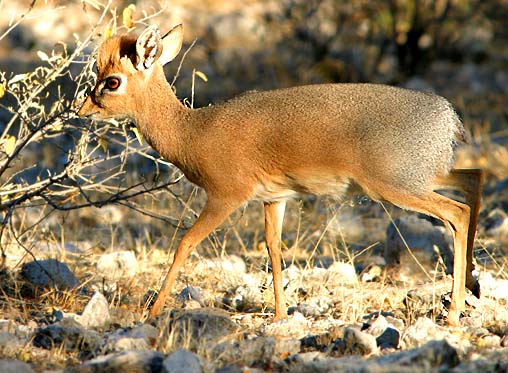 |
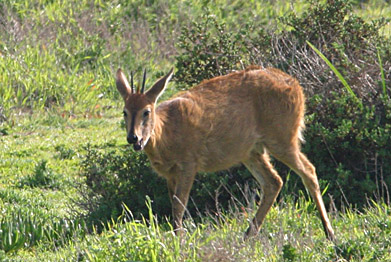 |
Sylvicapra grimmia * Duikers represent a new subfamily for us. This widespread species was encountered during the day in West Coast NP (photo left) and at dusk at N'kwazi Camp on the Kavango River in northeastern Namibia. |
|
Geosciurus inauris * This was a common species throughout the interior of western South Africa and Namibia. Ground-squirrels were particularly conspicuous and tame in parks like Kalahari-Gemsbok and Augrabies Falls (photo right). They behaved very much like California Ground-Squirrels in my home town. These were the dry thornveld squirrels that occurred north into Etosha NP, Namibia. Kingdon (1997) separates this genus from Xerus, the ground-squirrels of east Africa (but other authorities do not). |
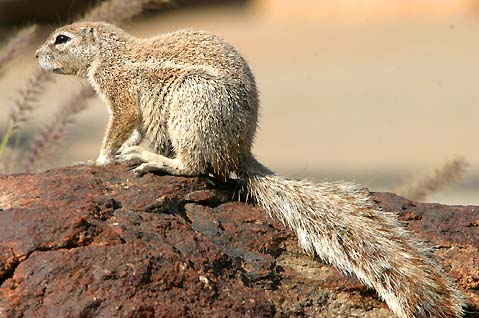 |
| Damara Ground-Squirrel Geosciurus princeps * | Two skittish ground-squirrels at the base of boulders at Spitzkoppe were this species on range and habitat. Like the hyraxes here (also a different species from the 'usual' ones), we did not get a chance to study them in any detail. |
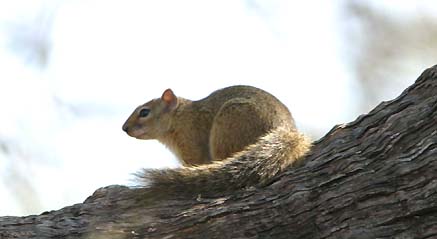 |
Paraxerus cepapi * We had a few of these squirrels, mostly in trees, across northern Namibia and Botswana. They were agile and active but curious. They were quick to grab unattended left-overs from our outdoor lunch at Halali Camp in Etosha NP. |
| Springhare Pedetes capensis * | A half-dozen were seen bounding about like little kangaroos on our first night drive in KGNP. More were seen at much longer range (eyeshine only but several sets of eyes bouncing) on the second night drive there |
|
Aethomys namaquensis * This i.d. could be wrong; indeed it could be dramatically wrong. However, in working with Kingdon (1997), and then the entire world list with ranges in Macdonald (1984), this is as close as I can get. If the genus is right, it seems likely the species is right (there are 10 species of Aethomys but only two reach South Africa). This rat or mouse was sitting in a small bush, just as you see, at the edge of the road in karoo scrub near Brandvlei. I got this shot out the window; it dashed into the bush once the car door opened. I called it 'red-eared mouse' in my field notes, for what that is worth. It was pretty large for a mouse, or about the size of a wood-rat in the U.S. |
 |
 |
Rhabdomys pumilio This mouse was common in grasslands of the Kalahari Desert; another (probably a different subspecies) was on the Cape of Good Hope. Kingdon (1997) says it has a wide but discontinuous range in cooler grasslands of southern Africa. You can see the back stripes in the photo; they were very apparent in the field. |
|
Parotomys brantsii One of the more unexpected and interesting creatures of the Kalahari was the whistling rat. They were common (200+/day) in roadside colonies. They are sociable animals, active by day, that live in a colony of burrows. They feed on vegetation outside the burrows and must form a significant bulk of prey for diurnal predators. When alarmed they whistle loudly and stamp their feet before disappearing underground (Macdonald 1984). We heard these high pitched whistles on our first day in the park, and wondered if something was wrong with the engine of our car, or was in Rita's video-camera? Eventually we traced the source to these critters, and thereafter found them everywhere. The Park Service personnel didn't seem to know about them. I bet most visitors — looking for big game — spent days in the park without seeing them, although they are everywhere.
|
| South African Porcupine Hystrix africaeaustralis * | One was seen foraging along the edge of the road during a night drive in Kalahari-Gemsbok Nat'l Park. It was this species on range; it is difficult to separate this species from Crested Porcupine H. cristata on pelage. The two species overlap only in east Africa. |
|
Petromus typicus * This is the only living representative of the family Petromyidae, although the fossil record shows it to have been large and diverse. The Dassie Rat has a flattened skull and flexible ribs which allow it to squeeze into rock crevices. It can be variable in color, mimicking the rock color. They are apparently most closely related to African porcupines and to Cane Rats [another small rodent family; altogether there are 30 families of rodents]. The long tail has scattered hairs and long white hairs at the tip. We saw only a couple, at Spitzkoppe and at Erongo Wilderness Lodge, in the same rocky slopes that held hyraxes. |
 |
| Cape Hare Lepus capensis * | One on a night drive in the karoo outside Brandvlei was thought to be this species on range and habitat |
| Scrub Hare Lepus saxatilis | Large rabbits seen on Kalahari night drives, and again at Anib Lodge and Etosha NP, were thought to be this species on range and habitat. It is very difficult to separate this species from Cape Hare and usually the views are too poor to even try. |
| lesser elphant-shrew Elephantulus sp? possibly Western Rock Elephant-Shrew E. rupestris | A small elephant-shrew dashed across a rocky dirt road in Daan Viljoen Game Reserve just west of Windhoek. Efforts to relocate it after stopping failed. On range it was either E. rupestris or Bushveld Elephant-Shrew E. intufi; my i.d. guess is based on habitat not field characters. This genus favors areas stocked with wild of domestic herbivores due to the dependence of certain invertebrates on dung and plant litter; those invertebrates are the prey for this mammal. |
|
Nycteris thebaica * |
This solitary bat, about the size of my hand, was hanging upside down
from the back wall of the women's' outhouse in the middle of Etosha Nat'l
Park. Note how cleverly it is hanging by its back toes on the uneven plaster
edge between the gray-plastered roof and the white-painted side. There
are 11 species of slit-faced bats in the world (10 in Africa, the other
in southeast Asia), all in the genus Nycteris. They form the family
Nycteridae. They are long-eared, broad-winged bats with long, silky fur
and a long tail fully enclosed in a membrane. The tail tip is in either
a "Y" shape (as in our bird (below left) or a "T" shape; the latter
is entirely unique among mammals. They have a nose trench, or slit, that
ends at the nose (below right), clearly visible in these shots with
a 'point-and-shoot' digital camera. They have a slow, moth-like flight
(facts from Kingdon 1997, Macdonald 1984).
Of the 11 slit-faced bats in the world, only two species range to southern Africa: Egyptian Slit-faced Bat N. thebaica (widespread south of the Sahara and also Egypt, the Middle East, and Morocco) and Hairy Slit-faced Bat N. hispida (range given as Senegal to Ethiopia to S Africa). The language of the latter range suggest it might not include Namibia and, in any event, this bat did not seem particularly hairy. Etosha is very arid country, like Egypt or the Middle East, so it seems quite likely this is N. thebaica. Slit-faced bats are known to roost in buildings, often singly, as well as caves, rock cliffs, and trees. They are said to give birth twice a year (Macdonald 1984). |
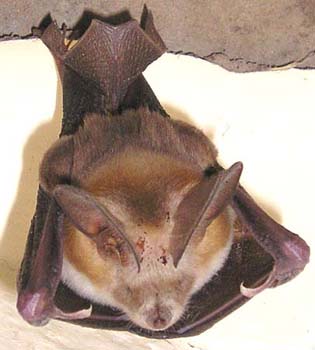 |
 |
| bats sp? | Other small bats were seen in flight at dusk at several locales that had water; most were over the Okavango River in Botswana. We have no idea even what family these represented. |
|
|
|
|
|
|
|
|
|
|
|
|
PHOTOS: All photos on this page are © 2005 Don Roberson; all rights reserved. Many other shots from this trip are scattered about this web site. Check particularly bird families, mammals, and herps listings.
Literature cited:
Kingdon, J. 1997. The Kingdon Field Guide to African Mammals. Academic Press, London.TOPMacdonald, D., ed. 1984. The Encyclopedia of Mammals. Facts on File Publ., New York.
GO TO LIST OF BIRD FAMILIES OF THE WORLD